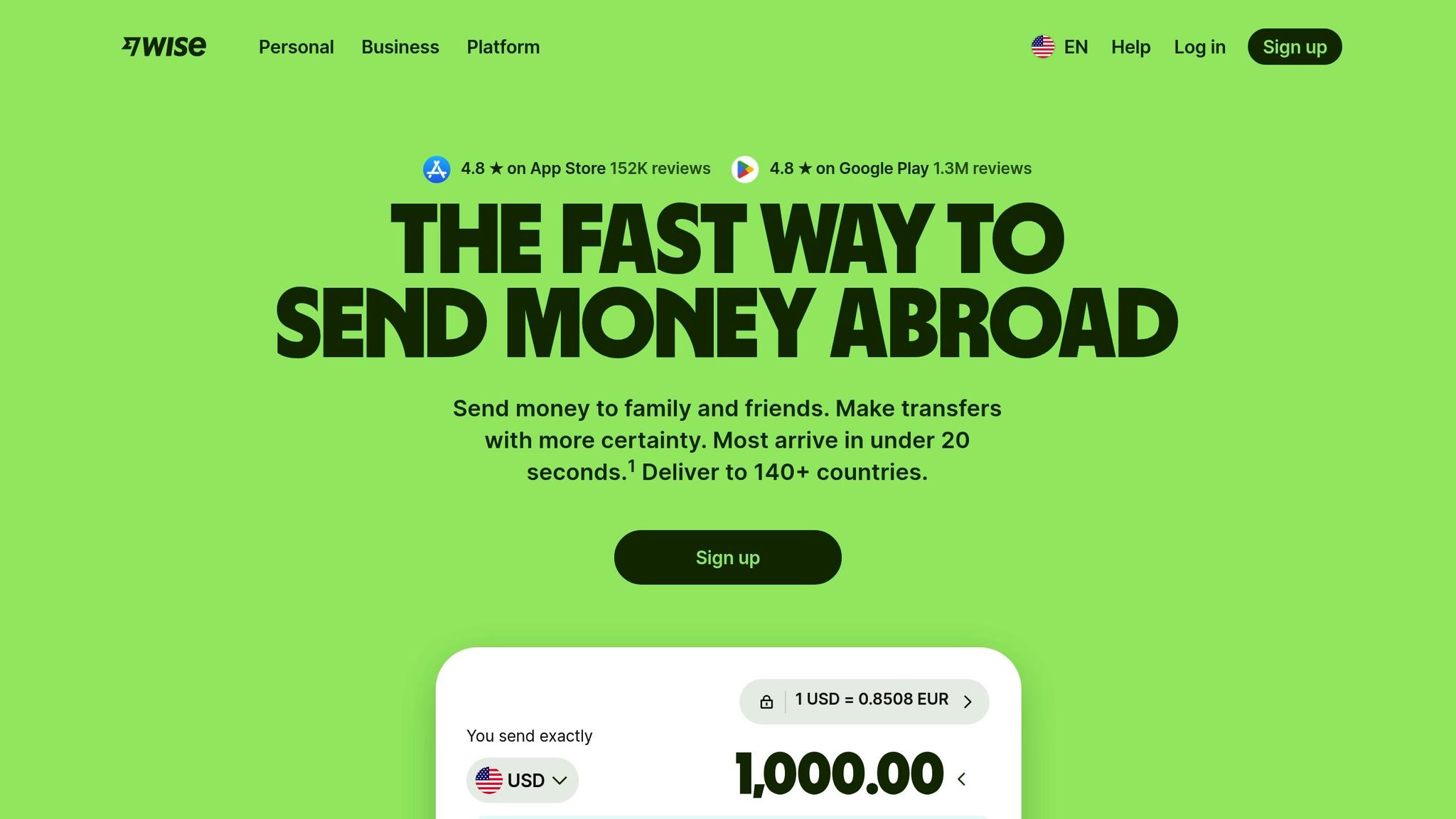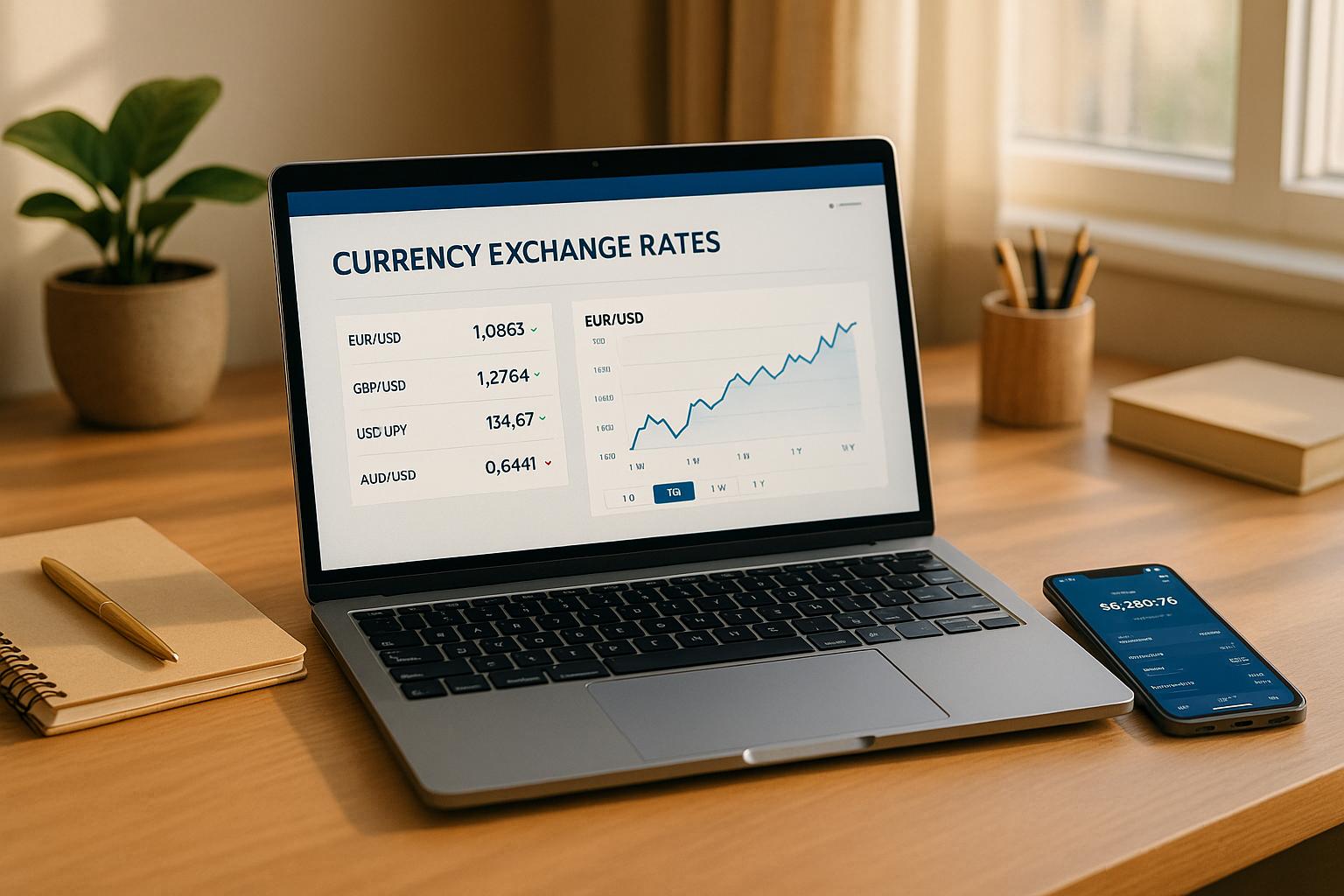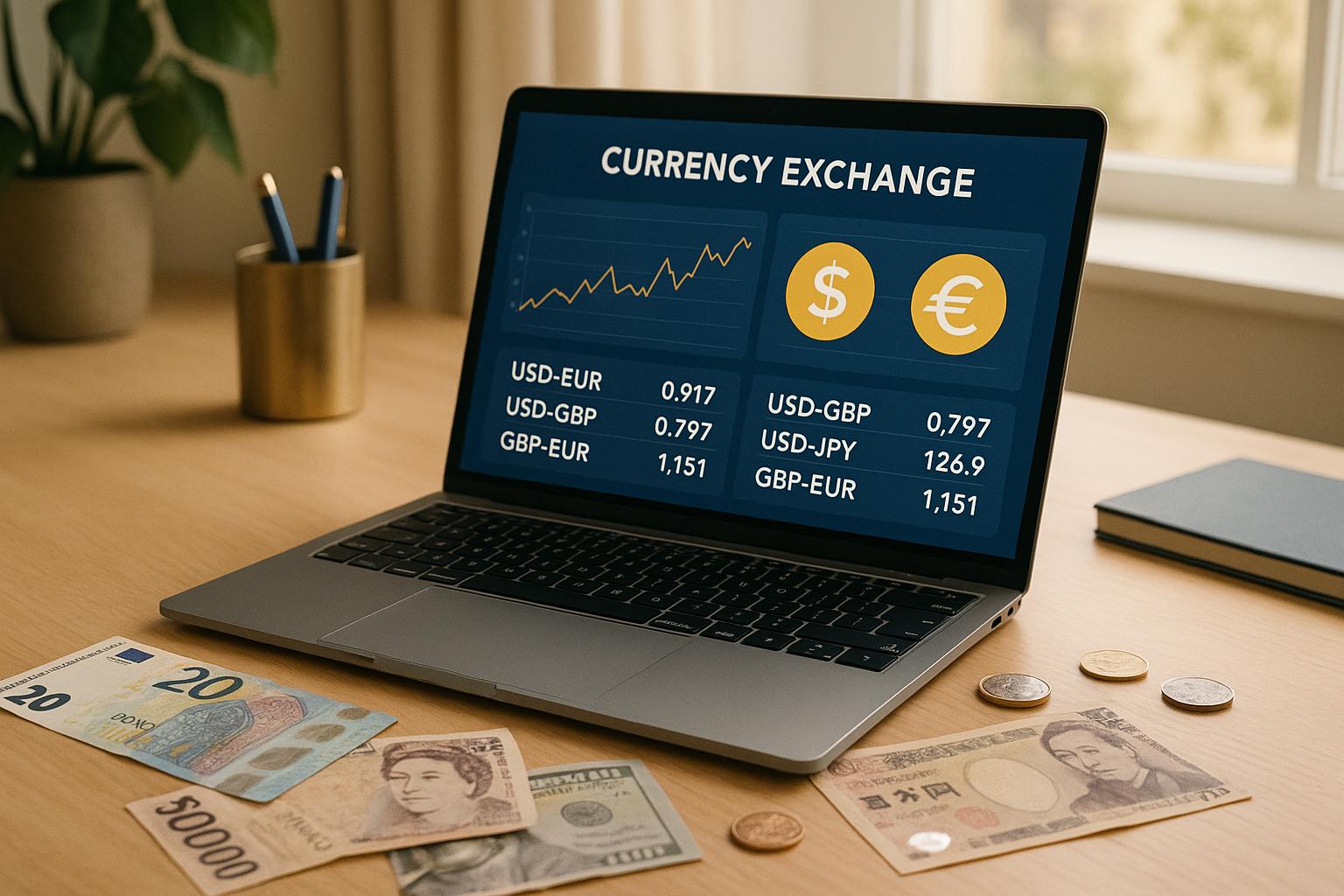Currency exchange rates impact the cost of international transactions for UK businesses. Even small rate changes can affect your profits. Here’s what you need to know:
- Rates vary between providers: High street banks often charge higher markups and fees compared to specialist brokers.
- Understand rate types: Spot rates are for immediate exchanges, while forward contracts let you lock in a rate for future transactions.
- Compare rates carefully: Use tools like mycurrencycost.com to compare quotes against the mid-market rate and uncover hidden costs.
- Timing matters: Exchange rates fluctuate due to market conditions, so monitoring trends or using rate alerts can save money.
- Larger transactions often get better rates: Providers may offer discounts for high-value exchanges.
The Truth About Wise Currency Exchange (vs Banks)

How Currency Exchange Rates Are Set
Currency exchange rates are determined by global market dynamics and the markups applied by currency providers. For UK businesses, understanding this process can shed light on why exchange rates differ between providers.
The Interbank Rate: A Key Benchmark
The interbank rate, also known as the mid-market rate, is the rate at which major banks trade currencies with one another. Think of it as the "wholesale price" of currency exchange. It serves as a baseline for pricing, with banks and foreign exchange (FX) brokers adding their own markups to this rate when offering services to customers. Tools like those on mycurrencycost.com allow businesses to compare quoted rates with the interbank rate, making it easier to identify how much of a markup is being applied.
Factors That Influence Exchange Rates
Exchange rates are shaped by a variety of factors that drive the supply and demand for currencies. Economic indicators, such as interest rate changes by the Bank of England, can significantly impact the value of the pound. Political developments and periods of uncertainty have also caused notable fluctuations in recent years. Trade balances play a role too - when UK exports exceed imports, demand for sterling increases, whereas a trade deficit can weaken the currency. Market sentiment and speculation amplify these effects, as traders respond not only to current events but also to expectations about future trends. These forces also explain the differences between spot rates and forward rates.
Spot Rates vs Forward Contract Rates
Spot rates are used for immediate currency exchanges, typically settling within two business days (T+2). These rates reflect real-time market conditions and can fluctuate throughout the day as supply and demand shift. Forward contracts, on the other hand, allow businesses to lock in a specific exchange rate for a future date, accounting for interest rate differences between currencies. This approach offers budget certainty and shields businesses from potential adverse rate movements. For companies with predictable foreign currency needs, forward contracts can be a practical choice. Tools like forward contract rate checks on mycurrencycost.com can help businesses evaluate whether securing a future rate is more advantageous than relying on the current spot rate.
Understanding these aspects of currency exchange lays the groundwork for examining why rates vary between providers.
Why Exchange Rates Differ Between Providers
Now that we've explored how exchange rates are determined, let’s dive into why the rates vary across different providers. Several factors influence these differences, and understanding them can help businesses and individuals make more informed choices.
Provider Markups and Fees
One of the main reasons for rate differences is the markup providers add to the interbank rate to generate profit. High street banks often apply larger markups compared to specialist foreign exchange (FX) brokers. On top of that, some providers charge additional transaction fees, which can vary depending on the size of the transfer and its destination.
Specialist FX providers tend to be more transparent, breaking down their margins and fees clearly, which makes it easier to compare costs. In contrast, traditional banks usually embed their profit margins within the quoted rate, often masking the true cost of the transaction. This lack of clarity can make it harder for businesses to understand exactly what they’re paying.
Frequency of Rate Updates
Another critical factor is how often providers update their rates. Some providers adjust their rates in real time, while high street banks might only update theirs a few times a day. Specialist FX providers typically offer more frequent updates - sometimes even in real time - ensuring their rates stay closely aligned with market fluctuations. This can be especially important during periods of market volatility, where even small delays in rate updates could result in less favourable pricing.
Discounts for Larger Transactions
Larger transactions often come with better rates. Many providers use tiered pricing, meaning the higher the transaction amount, the lower the percentage markup applied. Businesses or individuals making consistent, high-volume transactions might even qualify for preferential pricing or discounts. Similarly, forward contracts - agreements to lock in a rate for a future transaction - tend to offer more attractive pricing for larger values.
For businesses looking to maximise savings, tools like those available on mycurrencycost.com can be incredibly useful. These tools allow users to see how transaction sizes impact rates, helping them identify the most competitive options.
How to Compare Exchange Rates
When it comes to comparing exchange rates, it’s not just about looking at the numbers on the surface. To get the best value, you need to consider all the associated costs, including hidden markups and fees. By combining real-time data, historical trends, and structured tools, you can make more informed decisions.
Using Live and Historical Data
The mid-market rate is your best starting point. This rate represents the fee-free, real exchange rate and serves as a benchmark for evaluating the quotes you receive from banks or brokers. By comparing their rates against the mid-market rate, you can uncover the markup they’re adding.
Historical data is another powerful tool, especially when timing matters. Analysing past exchange rate trends helps you spot patterns in market volatility, which can guide you towards better timing for your transactions. Platforms like mycurrencycost.com offer visual charts that make it easier to identify these trends and plan accordingly.
To simplify the process, consider setting up rate alerts. Instead of constantly monitoring the market, these alerts notify you when your desired exchange rate is reached. This is particularly handy for businesses planning future payments, as it allows them to take advantage of favourable rates without needing to keep a constant watch on fluctuations.
By combining live and historical data with automated tools, you can gain a clearer view of market movements and identify opportunities to save.
Creating a Comparison Table
A comparison table is a straightforward way to see the true cost differences between providers. Let’s take a hypothetical transaction - £100,000 to EUR - and compare quotes from different sources:
| Provider Type | Rate Offered | Amount Received (EUR) | Markup vs Mid-Market | Additional Fees |
|---|---|---|---|---|
| Mid-Market Rate | 1.1650 | €116,500 | 0% | £0 |
| High Street Bank | 1.1450 | €114,500 | 1.72% | £25 |
| Specialist FX Broker | 1.1620 | €116,200 | 0.26% | £0 |
| Online Platform | 1.1580 | €115,800 | 0.60% | £15 |
This table highlights how even a seemingly small rate difference can lead to a significant cost. For instance, using a high street bank instead of a specialist broker for this transaction would cost £2,000 more. When you factor in additional fees, the gap becomes even wider.
To ensure accuracy, request quotes from all providers within the same hour and ask for the total amount received, including any fees.
Checking Forward Contract Rates
For transactions beyond immediate exchanges, forward contracts offer another option. Unlike spot rates, forward rates take into account interest rate differentials between currencies and market expectations of future movements.
The formula for calculating a forward rate is:
Spot Rate × (1 + Interest Rate A)^T / (1 + Interest Rate B)^T.
For example, with a GBP/USD spot rate of 1.2500, a UK interest rate of 4.00%, a US interest rate of 5.25%, and a contract term of six months, the theoretical forward rate would be 1.2425.
However, providers typically add their own margin to this theoretical rate. When comparing forward contract quotes, you’ll need to weigh this margin against your cash flow needs and risk tolerance. Forward contracts protect you from currency fluctuations but also lock you into a fixed rate, which might not always work in your favour if the market moves unexpectedly.
For businesses handling regular international payments, a hybrid strategy can be effective. This involves using forward contracts for predictable expenses while leaving room for flexibility with spot contracts for variable transactions. To make this work, compare both spot and forward rates from the same provider to ensure their pricing structure aligns with your needs.
Tools on platforms like mycurrencycost.com can help you analyse how transaction sizes affect both spot and forward rates. This ensures you’re selecting the most competitive options based on your specific requirements and timelines.
sbb-itb-1645b7c
Tips for Getting Better Exchange Rates
When it comes to securing favourable exchange rates, it's not just about comparing numbers. Timing, risk management, and expert advice can all play a critical role in minimising costs and maximising value.
When to Exchange Currency
Timing your currency exchanges can make a difference, but you don’t need to aim for pinpoint accuracy. Instead, focus on understanding patterns of volatility and keeping an eye on major economic events that tend to shake up currency markets. Announcements like central bank meetings, employment figures, or inflation updates often cause short-term rate swings.
If you’re looking for better rates, consider exchanging during periods of lower demand. For larger sums, spreading transactions over multiple dates instead of exchanging everything at once can help smooth out the effects of market fluctuations. Businesses with regular international payments might find it more practical to set target rates for transactions rather than constantly monitoring the market.
Using Forward Contracts to Lock in Rates
Forward contracts can be a practical option if you know you’ll need to make payments in the future. These contracts let you lock in today’s rate for a transaction on a future date, giving you more certainty over cash flow and shielding you from unfavourable rate changes.
A common strategy is partial hedging - securing a portion of your funds at a fixed rate while leaving the rest for spot transactions. This approach balances protection against big rate swings with the chance to benefit if rates move in your favour. For businesses with seasonal or irregular international payments, flexible forward contracts, which allow you to withdraw funds in portions, can add extra convenience and control.
Getting Expert Help
While tools and strategies are valuable, expert advice can take your currency management to the next level. For businesses that deal with multiple currencies or large volumes, professional guidance is essential. Services like those offered by mycurrencycost.com combine robust rate comparison tools with tailored hedging strategies to align with your cash flow and risk management goals.
Currency experts can provide timely advice by tracking economic calendars and identifying periods of likely rate volatility. If you’re new to international payments, they can help you establish effective practices, from setting realistic rate targets to choosing the right hedging strategies. Regular consultations ensure your approach adapts as your business grows, helping you navigate the complexities of the foreign exchange market with greater confidence. By pairing expert insights with technical tools, you can create a well-rounded and effective currency management plan.
Currency Exchange Terms Explained
Grasping the terminology of foreign exchange can help you make smarter choices and spot hidden fees. These key terms are essential to understanding how currency markets function and how providers determine their pricing. They also support the pricing strategies and comparisons mentioned earlier.
Spread and Markup
The bid-ask spread refers to the gap between the price a dealer is willing to pay for a currency (bid) and the price they’re willing to sell it for (ask). Markup, on the other hand, is an additional percentage that providers tack onto the interbank rate.
Together, the spread and markup mean the rate you get is less favourable than the interbank rate.
For instance, if the interbank rate is 1.2500 EUR/GBP, a provider might add a 2% markup, resulting in a rate of roughly 1.2250. On a £50,000 transaction, that markup could cost you an extra £1,000 compared to the interbank rate.
Spot Rate and Forward Contract
A spot rate is the current market price for a currency exchange that happens immediately (usually settled within two business days). When you check live rates online, you’re looking at spot rates that shift throughout the day based on market activity.
A forward contract rate, however, is a pre-agreed price for a currency exchange set to happen on a specific future date. These rates differ from spot rates because they account for interest rate differences between currencies and the time value of money.
Spot rates are ideal for immediate exchanges, while forward contracts lock in a rate for future transactions.
Mid-Market Rate
The mid-market rate is often considered the fairest measure of a currency’s value. It’s calculated as the average of the bid and ask prices in global markets, giving a transparent picture of a currency’s actual worth.
Although you’re unlikely to receive the mid-market rate directly, comparing it to your provider’s quote can reveal the true cost of your transaction. Keep in mind that this rate changes constantly due to global supply and demand, economic trends, and geopolitical factors, so timing plays a role in how much you ultimately pay.
Understanding these terms can help you better evaluate exchange rate quotes and make more informed decisions.
Conclusion: Main Points for Business FX Success
Currency exchange rates can have a direct and noticeable impact on your margins and cash flow. Since exchange rates are always shifting due to factors like economic trends, central bank policies, and market sentiment, the timing of your transactions and the provider you choose can significantly influence your costs. Here’s a summary of the key elements to keep in mind for managing currency exchange effectively.
Understanding the terminology is crucial. Hidden fees can quietly add up, costing your business thousands of pounds each year. Always use the mid-market rate as a benchmark to assess whether the deal you’re getting is fair.
When it comes to securing a competitive rate, comparing providers is essential. Even a seemingly small difference in fees, such as 1.5% versus 2.5%, could translate into significant savings - £1,000 on a £100,000 transaction, for example.
Timing also plays a critical role. Spot rates fluctuate throughout the day, but forward contracts can help you lock in rates for future transactions, offering much-needed budget certainty. This is especially useful for businesses with regular international payments or those planning major overseas investments.
Transparency tools can be game-changers in reducing excessive fees and finding competitive rates. Platforms like mycurrencycost.com let you compare your provider’s rates against real market rates, so you can see the true cost of your transactions. Features like historical rate analysis and forward contract rate checks give you the data to make smarter, more strategic decisions.
For example, a business making monthly international payments of £20,000 could save thousands of pounds annually by securing rates that are just 1-2% more competitive. These savings can quickly add up over time, freeing up resources to fund growth initiatives, improve cash flow, or enhance profitability.
FAQs
How can UK businesses use forward contracts to manage currency exchange risks effectively?
Forward contracts enable UK businesses to secure an exchange rate for a future date, shielding them from the unpredictability of currency fluctuations. By locking in a fixed rate, businesses can maintain steady cash flow, protect profit margins, and streamline financial planning.
This option is particularly useful for owner-managed businesses with turnovers ranging from £1 million to £50 million, helping them manage risks tied to international transactions. However, while forward contracts offer stability, it’s crucial to weigh their costs and limitations to ensure they suit your business requirements.
What causes currency exchange rates to change, and how can businesses keep track of these fluctuations?
Currency exchange rates fluctuate based on a variety of factors, such as interest rates, inflation, trade balances, political stability, and market sentiment. For instance, a nation with higher interest rates or a stable political environment often experiences a stronger currency. On the flip side, uncertainty or rising inflation can lead to a weaker currency.
Businesses looking to navigate these changes can leverage tools like real-time rate alerts, historical data charts, and market analysis resources. These tools provide insights into rate trends and movements, helping businesses plan ahead and secure favourable exchange rates.
Why do exchange rates vary between banks and specialist currency brokers, and how can businesses find the best option?
Exchange rates vary significantly between high street banks and specialist currency brokers, largely because of differences in their operations and pricing structures. Banks often apply higher margins - usually ranging from 2% to 5% - to account for their extensive range of services and operational expenses. In contrast, specialist brokers focus exclusively on currency exchange, which means they have lower running costs and can offer more competitive rates, often with margins below 1%.
When deciding on a provider, businesses should weigh several key factors: the exchange rate available, any fees involved, the security of the transaction, and whether the provider is regulated by an established authority. For owner-managed businesses handling substantial currency transactions, specialist brokers are often the smarter option. They not only offer better value but also provide tailored support for handling larger sums.

